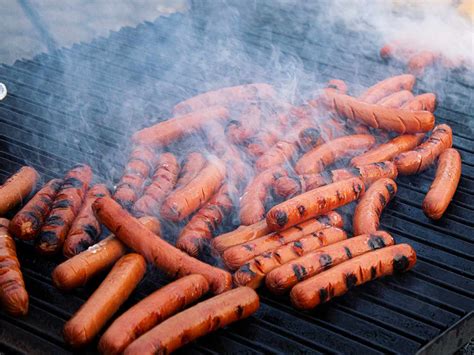
A father’s simple yet ingenious hot dog grilling technique, involving spiral-cutting the dogs before cooking, is gaining traction as a game-changer for backyard barbecues, promising enhanced flavor, even cooking, and improved topping adherence.
This Father’s Day, forget fancy gadgets and complicated recipes. A viral grilling trick, popularized by a dad sharing his father-in-law’s time-tested method, is revolutionizing how hot dogs are prepared. The secret? Spiral-cutting the hot dogs before placing them on the grill. This seemingly minor alteration promises a cascade of benefits, from superior flavor infusion to preventing those frustrating rogue toppings. The technique is rapidly gaining popularity, with barbecue enthusiasts and home cooks alike hailing it as a transformative approach to a cookout staple. This article delves into the specifics of the method, explores its advantages, and investigates why this straightforward technique has become a must-try for grilling season.
The technique itself is remarkably simple: before grilling, take a sharp knife and cut a spiral pattern along the length of each hot dog. The Yahoo! Life article features a video demonstrating the process. While variations exist, the core principle remains the same – creating grooves and exposed surfaces that interact more intensely with the heat and smoke of the grill. The spiral cut not only increases the surface area exposed to the grill but also creates pockets that cradle condiments and toppings, preventing them from sliding off.
According to anecdotal evidence and testimonials shared across social media, the spiral-cutting method addresses several common hot dog grilling woes. Firstly, it mitigates the “plumping” effect, where the hot dog swells and potentially bursts during cooking. The spiral cuts allow for expansion, preventing the casing from splitting and releasing valuable juices. Secondly, the increased surface area promotes more even cooking. Traditional grilling often results in unevenly cooked hot dogs, with some parts charred while others remain lukewarm. The spiral cut ensures that the entire hot dog is exposed to consistent heat, leading to a uniformly cooked product.
Beyond the practical advantages, proponents of the spiral-cutting method emphasize the enhanced flavor it imparts. The increased surface area allows for more Maillard reaction, the chemical process responsible for the browning and savory crust that is so desirable in grilled foods. As the hot dog cooks, the spiral cuts create a network of crispy, caramelized edges that deliver a burst of flavor with every bite. Furthermore, the grooves created by the cuts act as tiny reservoirs, capturing and intensifying the smoky flavor from the grill.
The method’s simplicity is a significant part of its appeal. Unlike complicated grilling techniques that require specialized equipment or advanced culinary skills, spiral-cutting hot dogs requires only a sharp knife and a few extra seconds of preparation. This accessibility makes it an ideal technique for both seasoned grill masters and novice cooks. The ease of execution combined with the tangible improvements in flavor and texture have contributed to the method’s widespread adoption.
While the spiral-cutting technique is primarily associated with hot dogs, the underlying principles can be applied to other grilled sausages as well. Bratwurst, kielbasa, and Italian sausage can all benefit from the increased surface area and improved topping retention that the spiral cut provides. The technique is particularly well-suited for sausages that are thick and dense, as it helps to ensure even cooking throughout. However, it’s important to adjust the depth and spacing of the spiral cuts based on the size and type of sausage. For thinner sausages, shallower cuts may be sufficient, while thicker sausages may require deeper and more closely spaced cuts.
The article in Yahoo! Life quotes a father explaining how he learned the technique from his father-in-law, highlighting the intergenerational sharing of culinary knowledge. This anecdote underscores the cultural significance of grilling and the role it plays in family traditions. The sharing of tips and tricks, like the spiral-cutting method, fosters a sense of community among grilling enthusiasts and contributes to the ongoing evolution of barbecue culture.
Another advantage of this method is its versatility concerning toppings. Whether you prefer classic ketchup and mustard, chili and cheese, or gourmet combinations like caramelized onions and kimchi, the spiral cut provides a stable platform for holding toppings. The grooves act as channels, preventing toppings from sliding off and ensuring that each bite is a harmonious blend of flavors. This is particularly beneficial for loaded hot dogs with multiple toppings, where maintaining structural integrity can be a challenge.
The spiral-cutting method also lends itself to creative variations. Some grillers prefer to use a skewer to create a more uniform spiral cut, while others experiment with different cutting patterns, such as crisscross or diamond shapes. The choice of cutting pattern can affect the texture and appearance of the finished hot dog, allowing for personalization and experimentation. Additionally, the spiral cut can be combined with other grilling techniques, such as butterflying or scoring, to further enhance the flavor and texture.
One area that benefits immensely is the reduction of charring. Because the hot dog spirals, no single part of it sits on the grill for too long, reducing the amount of burning that can occur. The consistent turning and lifting needed to achieve this reduces the risk of carcinogenic build-up on the food’s surface.
While the spiral-cutting method has garnered widespread praise, some critics argue that it can make the hot dog more prone to drying out if overcooked. Because of the increased surface area, the hot dog can lose moisture more quickly, resulting in a dry and less flavorful product. To mitigate this risk, it’s important to monitor the internal temperature of the hot dog and remove it from the grill as soon as it reaches the desired level of doneness. Using a meat thermometer can help to ensure that the hot dog is cooked through without being overcooked. Another tip is to baste the hot dogs with a flavorful marinade or sauce during grilling to help retain moisture and enhance the flavor.
The rise of the spiral-cutting method reflects a broader trend towards culinary innovation and experimentation in the world of barbecue. Grillers are constantly seeking new and creative ways to enhance the flavor, texture, and presentation of their food. This trend is fueled by the proliferation of online resources, such as cooking blogs, YouTube channels, and social media groups, where grillers can share tips, recipes, and techniques. The spiral-cutting method is just one example of how these online communities are driving innovation in the barbecue world.
Ultimately, the appeal of the spiral-cutting method lies in its ability to elevate a simple dish to new heights. By taking a few extra seconds to prepare the hot dogs, grillers can unlock a range of benefits, from enhanced flavor and even cooking to improved topping retention. Whether you’re a seasoned grill master or a novice cook, the spiral-cutting method is a technique that’s worth trying. It is a perfect demonstration of how a simple tweak can drastically improve the results. The father-in-law’s grilling secret serves as a reminder that sometimes the most effective culinary innovations are the ones that are the most straightforward.
The cultural impact of this simple grilling hack shouldn’t be underestimated. It creates conversation, encourages experimentation, and adds a touch of fun to the cooking process. It’s also a democratic technique – accessible to anyone with a knife and a grill, regardless of skill level. This accessibility is crucial in fostering a wider appreciation for grilling and outdoor cooking.
Looking ahead, the spiral-cutting method is likely to continue to evolve as grillers experiment with different variations and modifications. Some may try using different types of knives to create unique cutting patterns, while others may explore the use of marinades or rubs to further enhance the flavor. The possibilities are endless, and the only limit is the imagination of the griller.
One of the most exciting aspects of the spiral-cutting method is its potential to inspire creativity in the kitchen. By encouraging grillers to think outside the box, it can lead to the discovery of new and innovative ways to prepare food. This spirit of experimentation is essential for the continued growth and evolution of barbecue culture.
The viral nature of this hot dog trick is a testament to the power of social media in shaping culinary trends. A simple tip, shared online, can quickly spread around the world, inspiring countless people to try it for themselves. This phenomenon highlights the democratizing effect of social media, which allows anyone to become a culinary influencer, regardless of their background or credentials.
The discussion surrounding the spiral-cutting method also raises important questions about the role of tradition in cooking. While some may view it as a departure from traditional grilling techniques, others may see it as a natural evolution of the craft. The debate over tradition versus innovation is a recurring theme in the culinary world, and it often sparks lively discussions among food enthusiasts.
The focus on simple techniques like the spiral cut also highlights a growing appreciation for the fundamentals of cooking. In an era of complex recipes and elaborate culinary creations, there is a renewed interest in mastering the basic skills that underpin all good cooking. This emphasis on fundamentals is a welcome trend, as it encourages people to develop a deeper understanding of the ingredients and techniques they are using.
The broader implications of the spiral-cutting method extend beyond the realm of grilling. It serves as a reminder that small changes can often have a big impact, whether it’s in the kitchen, in the workplace, or in life in general. By being open to new ideas and willing to experiment, we can often find simple solutions to complex problems.
In conclusion, the viral hot dog spiral-cutting trick is more than just a fleeting trend. It’s a testament to the power of simple ideas, the importance of sharing culinary knowledge, and the enduring appeal of barbecue culture. Whether you’re a seasoned grill master or a novice cook, it’s a technique that’s worth trying. You may just discover your new favorite way to prepare hot dogs. The ease, increased surface area for flavor and topping, and fun factor are making the dad’s trick a barbeque must-try.
Frequently Asked Questions (FAQ) about the Hot Dog Spiral-Cutting Trick:
1. What exactly is the spiral-cutting hot dog trick?
The spiral-cutting hot dog trick involves making a spiral cut along the length of the hot dog before grilling it. This is done by taking a sharp knife and carefully cutting a continuous spiral around the hot dog, exposing more of the meat’s surface. The purpose is to enhance the flavor, improve cooking, and make it easier for toppings to adhere. The Yahoo! Life article highlights a father sharing this technique which he learned from his father-in-law, marking it as a favorite.
2. What are the benefits of spiral-cutting hot dogs before grilling?
There are several purported benefits, including:
- Enhanced Flavor: The spiral cut increases the surface area exposed to the grill, promoting the Maillard reaction (browning) and creating a more flavorful, caramelized crust.
- Even Cooking: The increased surface area allows for more even cooking, preventing some parts from being charred while others remain lukewarm.
- Improved Topping Adhesion: The grooves created by the spiral cut act as channels that hold toppings in place, preventing them from sliding off.
- Prevents Bursting: Allows for expansion during the cooking process, preventing the casing from splitting.
3. How do you properly spiral-cut a hot dog?
To spiral-cut a hot dog, follow these steps:
- Place the hot dog on a cutting board.
- Hold a sharp knife at a slight angle to the hot dog.
- Begin cutting a spiral pattern along the length of the hot dog, rotating the hot dog as you cut. Be careful not to cut all the way through.
- Ensure the spiral cut is consistent and evenly spaced.
Some grillers prefer using a skewer to guide the knife and create a more uniform spiral.
4. Does spiral-cutting work for other types of sausages, or is it just for hot dogs?
While the trick is often associated with hot dogs, the principles can be applied to other grilled sausages such as bratwurst, kielbasa, and Italian sausage. The spiral cut helps ensure even cooking and improve topping retention, especially for thicker sausages. Adjust the depth and spacing of the cuts based on the size and type of sausage.
5. Are there any potential drawbacks to spiral-cutting hot dogs?
Yes, one potential drawback is that the hot dog can dry out more quickly if overcooked due to the increased surface area. To mitigate this:
- Monitor the internal temperature with a meat thermometer.
- Remove the hot dog from the grill as soon as it reaches the desired level of doneness.
- Baste the hot dogs with a flavorful marinade or sauce during grilling to help retain moisture.
Additional In-depth Information and Analysis:
The spiral-cutting hot dog trick, while seemingly simple, has ignited a conversation around grilling techniques and the pursuit of the perfect barbecue. This method serves as a microcosm of the broader trends in culinary innovation and the willingness of home cooks to experiment and share their findings. To fully appreciate the technique, it’s important to delve deeper into the science behind its purported benefits and explore its cultural context.
The Science of the Maillard Reaction:
The Maillard reaction is a chemical process that occurs between amino acids and reducing sugars, typically requiring heat. It is responsible for the browning and the development of complex flavors in cooked foods. In the context of the spiral-cut hot dog, the increased surface area created by the spiral cut allows for more of the hot dog’s surface to participate in the Maillard reaction. This results in a more pronounced savory, umami-rich flavor profile that many find appealing. The crispy, caramelized edges created by the spiral cut offer a textural contrast to the softer interior of the hot dog, enhancing the overall sensory experience.
Heat Transfer and Even Cooking:
Traditional grilling often results in unevenly cooked hot dogs because the heat source is not uniform, and the hot dog’s cylindrical shape means that some parts are closer to the heat than others. The spiral cut addresses this issue by increasing the surface area exposed to the heat. This allows for more efficient heat transfer, ensuring that the entire hot dog cooks more evenly. Additionally, the spiral cut can help to prevent the hot dog from curling or distorting during grilling, which can further contribute to uneven cooking.
The Role of Toppings in Hot Dog Perfection:
For many hot dog enthusiasts, toppings are an integral part of the experience. Whether it’s classic ketchup and mustard, chili and cheese, or more adventurous combinations, toppings can add layers of flavor and texture to the humble hot dog. However, keeping toppings on a round hot dog can be a challenge, especially when dealing with wetter or chunkier toppings. The spiral cut provides a practical solution to this problem by creating grooves that act as channels to hold the toppings in place. This ensures that each bite is a well-balanced and flavorful experience, with the toppings complementing the hot dog rather than sliding off.
Addressing the Drying-Out Concern:
The primary concern surrounding the spiral-cutting method is the potential for the hot dog to dry out due to the increased surface area. While this is a valid concern, it can be mitigated by taking a few simple precautions. As previously mentioned, monitoring the internal temperature and basting the hot dog with a flavorful sauce can help to retain moisture. Another strategy is to use a higher-quality hot dog with a higher fat content, as the fat will help to keep the hot dog moist and flavorful during grilling. Finally, avoiding overcooking is crucial. The ideal internal temperature for a hot dog is around 160°F (71°C).
Experimentation and Personalization:
The spiral-cutting method is not a one-size-fits-all technique. Grillers are encouraged to experiment with different cutting patterns, depths, and spacings to find what works best for them. Some may prefer to use a shallow spiral cut to maximize moisture retention, while others may opt for a deeper cut to maximize flavor and topping adhesion. The choice of cutting pattern can also affect the texture of the finished hot dog, with some patterns creating a more crispy and caramelized texture. The key is to experiment and find a technique that suits your personal preferences.
The Cultural Significance of Grilling:
Grilling is more than just a cooking method; it’s a cultural phenomenon that brings people together and creates lasting memories. From backyard barbecues to tailgate parties, grilling is often associated with socializing, celebration, and community. The sharing of tips and tricks, like the spiral-cutting method, is an important part of this culture, fostering a sense of camaraderie among grilling enthusiasts. These shared experiences and traditions contribute to the enduring appeal of grilling as a pastime and a form of culinary expression.
The Impact of Social Media on Culinary Trends:
The rapid spread of the spiral-cutting hot dog trick is a testament to the power of social media in shaping culinary trends. Platforms like YouTube, Instagram, and TikTok have become hubs for sharing cooking tips, recipes, and techniques. A simple video or photo can quickly go viral, inspiring countless people to try it for themselves. This democratization of culinary knowledge has empowered home cooks to experiment and innovate in ways that were previously unimaginable. The spiral-cutting method is just one example of how social media is transforming the way we cook and eat.
The Future of Grilling Innovation:
The spiral-cutting hot dog trick is likely to be just the beginning of a wave of grilling innovations. As grillers continue to experiment and share their findings, we can expect to see even more creative and inventive techniques emerge. From new ways to enhance flavor and texture to innovative approaches to heat control and fuel efficiency, the future of grilling is bright. The key is to remain open to new ideas and to embrace the spirit of experimentation.
In conclusion, the spiral-cutting hot dog trick is a simple but effective technique that can significantly enhance the grilling experience. By understanding the science behind its benefits and experimenting with different variations, grillers can unlock a new level of flavor and enjoyment. This technique represents a broader trend of innovation, showcasing how simple tips shared via social media can rapidly transform culinary practices. It reminds us that the best grilling is often achieved by continuous learning and a willingness to try new things. The ease of execution and the impressive results solidify this dad’s trick as a must-try for barbecues everywhere. The attention to detail, the commitment to quality, and the willingness to share knowledge are all hallmarks of a true grill master.









